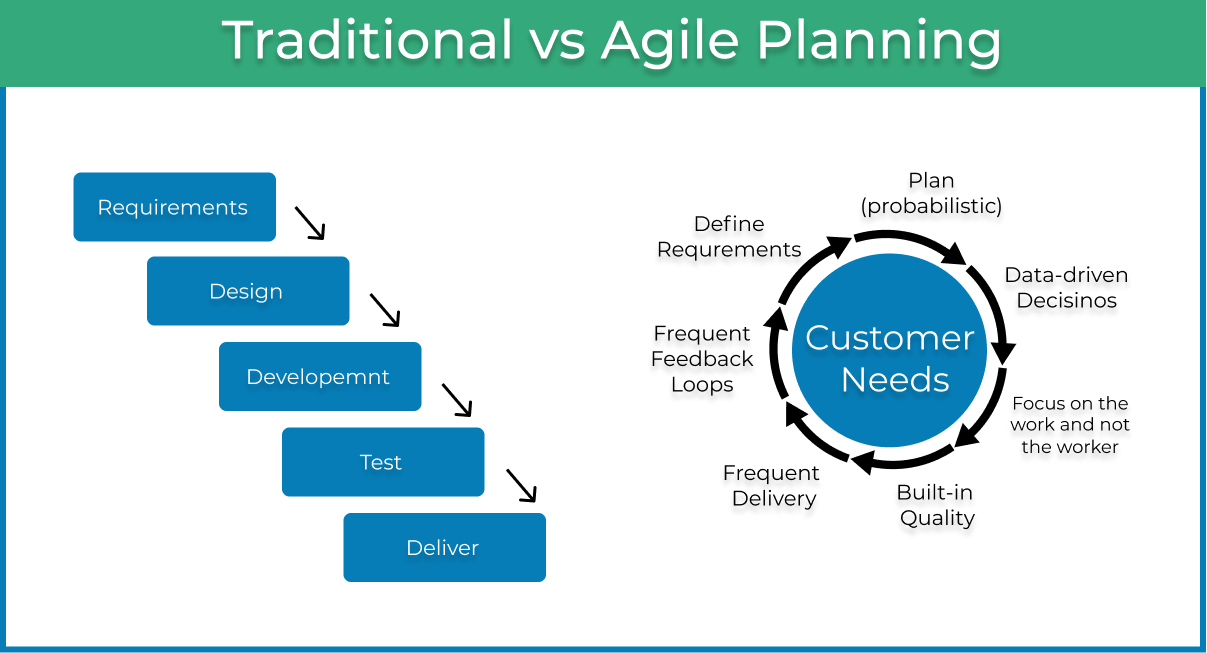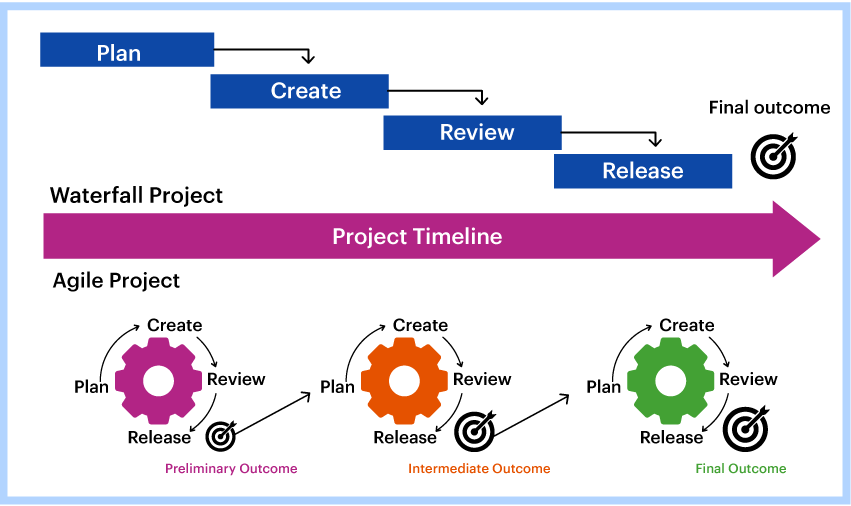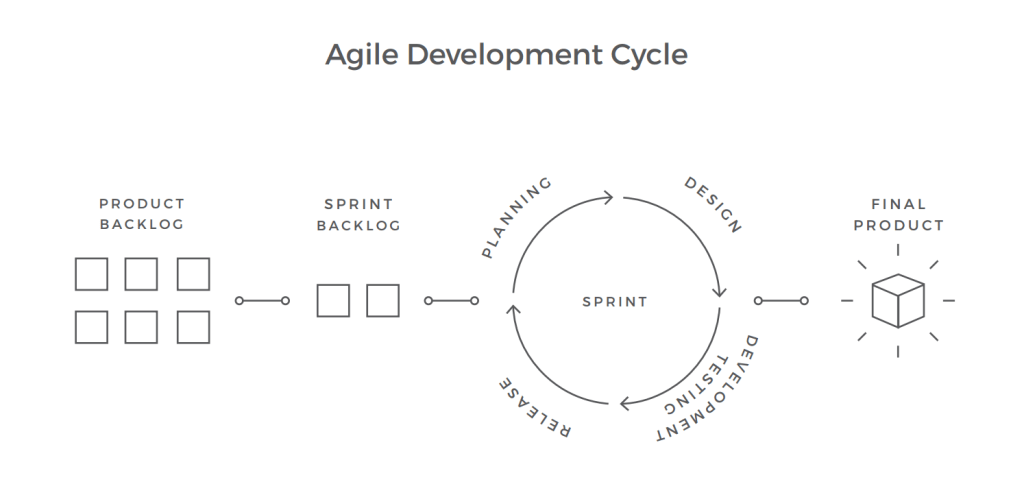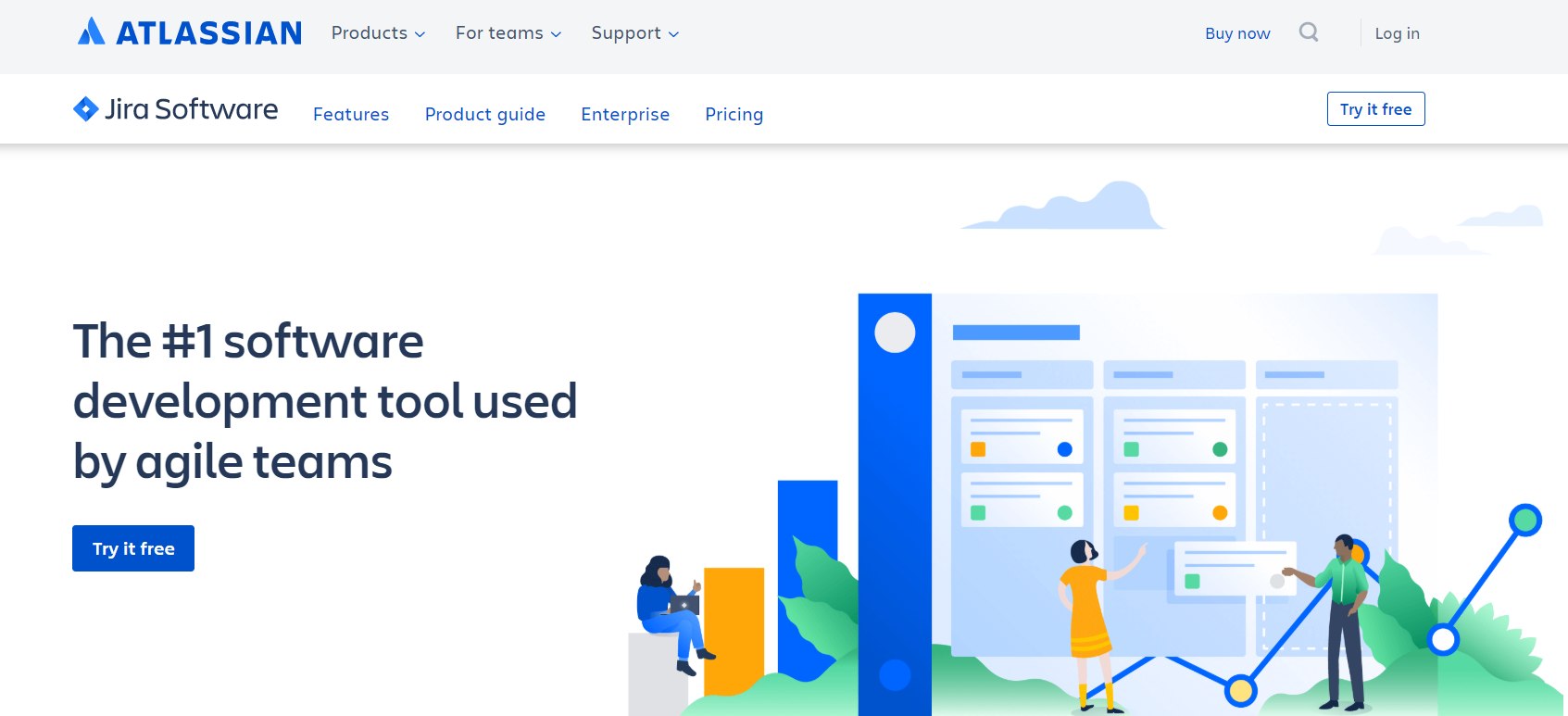Download this article on “Complete Guide to Agile Project Management” here.
For a couple of weeks, we’ve been preparing this guide to agile project management. We’ve gathered all the required information on agile project management and how to become a certified project manager.
Today, this kind of profession is one of the most required ones in the world.
Before delving into more details of Agile Project Management (APM), let’s see the glossary and the most common terms you’ll be using during your APM work.
Basic Terms: Agile Project Management Glossary
Agile – an iterative project management approach to manage projects in the IT-sphere.
Agile Development – a term used basically for iterative software development methodologies such as Scrum, eXtreme Programming (XP), and others.
Agile Manifesto – a brief document that includes 4 values and 12 principles for successful agile software development.
Backlog – prioritized work that still needs to be finished.
Burndown Chart – professionals use this to monitor the progress of the project. It shows the remained work that should still be done versus the total time left.
Cadence – the time (number of days, weeks, months) in a Sprint or the team’s development cycle length.
Ceremonies – meetings, often a daily planning meeting, that identify what has been done, what is to be done, and the barriers to success.
Disciplined Agile Delivery (or DAD) – process-decision guidelines providing context-specific guidance based on your business needs trying to increase the quality of your product.
Daily Scrum – a daily meeting with the team on planning, monitoring, and discussing the tasks.
DevOps (or Development Operations) – bridges the gap between agile teams and operational delivery to production.
Dynamic Systems Development Method (or DSDM) – this is an agile project delivery framework used in the software development processes.
eXtreme Programming (XP) – another agile development methodology that’s used in the software development process. It helps to produce higher quality software as well as a higher quality of life for the software development team members.
Kanban – a visual system for managing work processes.
Kanban Board – one of the key components of the Kanban methodology helping to monitor and reveal the status, progress, and issues related to the work process visually.
Lean – a method in software development that helps teams to deliver projects faster.
LeSS (large-scale Scrum) – agile development method that project managers apply to not just small teams but also to an agile team consisting of fifteen, hundred or even thousands of members.
Rapid Application Development (RAD) – agile development method that highlights the use of software and user feedback to meet business requirements.
Requirements – in the case of Agile projects also known as “user stories” is the document mentioning all the capabilities you want in a planned system.
Scaled Agile Framework Enterprise (or SAFe) – is another Agile methodology used during the software development process.
Scaled Agile – is a toolbox guiding companies in scaling lean and agile practices (agile scaled up to large projects or programs).
Scrum – one of the worldwide known methodologies used in software development helping teams to review and see the progress of a single development phase (also called Sprint).
(The) Scrum of Scrums – a technique used for multiple teams working on the same product/project.
Scrum master – this is (hopefully) you – the person who’s monitoring the whole development process and assures everyone’s delivering their work on time.
Sprint – a short development phase within a larger project. For example, it’s when teams define a short duration of a Sprint (in a large project) up to 5 days to 4 weeks timebox.
Sprint retrospective – is a good opportunity for the team to review their own work and create a reshaped plan for improvements that have them discussed/implemented during the next Sprint.
Velocity – some measure of the work done the working team can handle during one Sprint.
Waterfall – a structured project management approach helping software development teams to organize their work.
What is Traditional Project Management?
The traditional Project Management (meaning the waterfall approach) is a universal approach that includes a set of unique techniques used for planning, estimating, and controlling activities (in sequence).
In the case of traditional PM, every project follows the same life cycle. The standard life cycle includes some stages such as feasibility, planning, designing, building, testing, production, and support.
The entire project is planned beforehand (with fixed time and costs) with no changing possibility. So once the project development starts one should be extremely careful not to make any mistakes during its implementation.
What is Agile Project Management?
In short, Agile is a project management methodology.
The methodology includes sprints that are short development cycles focusing on continuous improvement in the development of a product, service, or process.
Today, agile project management is rapidly developing and it’s one of the top paid jobs in the world. Moreover, Agile projects are 28% more successful than traditional projects.
Also, according to various sources, the salary for agile project managers varies from $66,137 to $154,063 per year.
So if you’re still fluctuating whether to shift your career and become an agile project manager, it’s worth it!
To delve even more into Agile PM spend some minutes and explore what the Agile methodology is in the video below from Linkedin:
Difference Between Traditional Project Management & Agile Project Management
Many project managers and experienced developers use project management skills to handle their projects on time.
However, many of them prefer to use the Agile methodology instead of Traditional PM because of some reason.
1. Agile PM is More Flexible
In the case of traditional project management, one should define every single process right at the start of each project.
It cannot deal with any big change (or especially feedbacks) requiring some change in the process. In almost all the projects final delivery time and the costs along with budget are fixed. So one can change it very rarely.
When doing Agile project management, you do have a huge space for feedback from the clients’ side. Here the process is very flexible.
Moreover, clients follow the process and they can provide feedback at any stage of the project. In the end, you get a better product without a headache.
The reason is that the Agile PM methodology isn’t linear (compared to the Traditional PM) and doesn’t require a top-down approach. So you shouldn’t suffer from last-minute changes that can disrupt the project time frame.
2. Project Complexity
Overall, people use traditional project management methodology basically for not big and less complex projects.
As I’ve mentioned before, it doesn’t like unexpected changes. So here the Agile could be your best option to handle big and complex projects.
But why prefer Agile PM?
Because complex projects include multiple interconnected phases or just one stage. And here comes Agile PM to help you finish the bigger projects.
3. Delivery Speed
The speed does matter!
When it comes to finishing a project on time, anything can happen.
The Agile PM ensures that your team is safely and constantly delivering good-working products. This means that any client can get access to the product anytime without waiting for the final working version.
For example, they can wait for 6 months, 1 year, 2 years, or even more get the final version of the product. Agile PM makes the process much faster seeing the changes in much shorter intervals (very often every 2 to 4 weeks).
4. Transparency Option
The Agile PM methodology is quite transparent. The clients (or other people) can get access to the project’s every single phase (initiation, planning, review, testing).
The agile methodology allows a project’s team members to view the progress from the very start to the end.
5. Project Risk Level
During the Agile PM, the risk of a project failing is minimal.
A good project manager divides a large project into some iterations. Thus, they decrease the risk level of failing it.
In the case of traditional PM, you realize the real risk of the project when almost everything is done or when you get the project finalized.
Every project manager, project owner, or project financing organization wishes to use less time, effort, and money but get good final results. So this is their chance to get what they want and avoid any problems.
6. Checkpoints & Monitoring Progress
The traditional PM method advises spending much time planning the project at the analysis and design stage of the project. In this case, the focus is on smoothing the processes and not the product itself.
When the planning is over, the team members should follow the steps in that with minimal guidance.
One assesses the effectiveness of the project when it’s already completed. No regular meetings unless the PM receives any guidelines.
The Agile methodology encourages team members to meet and have checkpoints at regular intervals. When meeting every 2 or 4 weeks, it’s quite easier to check all the work done, its effectiveness, and discuss any issues on the way to the finish line.
If the work process requires more frequent meetings, you can use one of Agile other methodologies – Scrum. In this case, team members or numerous teams meet on a daily basis to discuss the work done after the last meeting, to make changes, or tackle the obstacles.
To visually show you the difference between traditional PM and Agile PM, we have researched and provided you the best infographics on the topic.
One of the best visual overall pictures I could found, you can see below (infographic from Kanbanize.com):

Here’s another good infographic from Kissflow.com:

And another infographic to fully show you the visual comparison of Agile project management and traditional project management (infographic from Knowledgehut.com):

Also, you should pay attention to the main characteristics of the two approaches.
Such characteristics include but not limited to a linear or iterative process, project’s scale (small, medium or large), client’s involvement in the work process, and others.
The full list of characteristics you can see in this infographic below:

Stages’ Difference Between Traditional PM & Agile PM (Lifecycles)
Stages of Traditional Project Management
Basically, there are 5 project management process groups:
- Initiating: This is the very first stage of the Traditional PM – it should define the project.
- Planning: Next, the planning phase includes developing the full roadmap for the project’s every member to follow.
- Executing & Monitoring: In this executing phase, you’re starting the project. When having the project started, the PM creates the working team and deliverables. Afterward, they monitor and measure project performance to ensure how it’s going.
- Closing: The completion of the project. After finishing the project, it’s being transferred to another team who will maintain it.
Stages of Agile Project Management
In general, there are 6 basic stages of the Agile Development Life Cycle:
- Scope out and prioritize projects
- Diagram requirements for the initial sprint
- Construction/iteration
- Release the iteration into production
- Production and ongoing support for the software release
- Retirement
We’ll not make it even longer and will definitely advise you to read the article from Lucidchart.com on “The stages of the Agile software development life cycle.”
Agile Methodologies
There are a variety of Agile methodologies in the world today.
We’ve mentioned some of the most frequently used by the Agile project managers. Those methodologies include but not limited to the following:
- Kanban
- Scrum
- Disciplined Agile Delivery (DAD)
- Agile Unified Process (AUP)
- Scrumban
- Crystal
- Crystal Clear methods
- Adaptive Software Development
- Feature Driven Development
- Agile Modeling
- Lean Software Development, etc.
All in all, the key role of each Agile method is to avoid any obstacles (by adapting to change, like Chameleons) and deliver working software (or a good-working final product/project) as quickly as possible.
However, even though the goal of each mentioned methodologies is the same, each team’s process flow may vary depending on the project’s or product’s specifications.
Related Article: Best Project Management Courses Online (Free & Paid)
When You Shouldn’t Use the Agile Project Management Method
Although the Agile has huge advantages and benefits, it’s not considered for every project/organization.
But how to identify when the Agile PM isn’t the best methodology to use?
To make your job easier, I have gathered 4 cases when the Agile development model isn’t the best option for your projects.
1. The final outcome of your project is quite stable and well-understood
As you may already know, people use Agile to reduce the cost of the occurred change and uncertainty.
In contrast, if there are very little uncertainty and a low possibility of change, then you can use another methodology rather than Agile.
For instance, if you work in a patent industry with heavy regulations you don’t need iterative planning and multiple drafts.
2. Your project must produce a repeatable deliverable
From the very beginning to the end, Agile’s core function is to create a unique product, service, or result.”
But imagine a situation when a customer asks you to construct 10 identical houses. In this case, your final product/result will be 10 unique houses and not 5 identical ones.
So one of the disadvantages of Agile is that it’s not considered for reproducibility.
3. Perhaps, your customer doesn’t want Agile
An Agile project requires being constantly in touch with your end customer.
But there are some cases when customers don’t have the time, will, or ability and don’t desire to dedicate to a project. So if the project contains a low value or low risk, they may prefer a more traditional methodology instead of using the Agile one.
4. Your company cannot support Agile
If your company, product, or project team isn’t ready for Agile, trying to adopt it can contain some risk to your project. So be sure they have all the resources to cross the finish line.
Key Differences Between a Project Manager & Agile Project Manager (or Scrum Master)

The Project Manager manages a project on a day-to-day basis and is the only person with monitoring on the changes of the project.
Also, if there are no managers within the company they implement Project Support and Team Management.
On the other hand, the main responsibility of the Scrum Master is to monitor and manage the Scrum Framework (according to the Scrum Guide).
For the detailed information you can read this article from Medium on Scrum Master vs Project Manager – An overview of the differences.
The 12 Agile Principles
Overall, Manifesto for Agile Software Development highlights 12 Agile principles for all the projects to follow.
We’ll keep short and just mention the 12 Agile Principles:
- The top priority is customer satisfaction: one should achieve it via fast and continuous delivery.
- Project managers can implement changes at any stage of the process (for customer’s competitive advantage).
- Project managers deliver the product or service with a higher frequency.
- Both stakeholders and developers (or their team members) cooperate with each other closely on a daily basis (not to miss any issues).
- It’s more efficient to build projects around motivated people. The role of PM should be to provide all the necessary environment and support they need to do the job in the best possible way.
- All in all, face-to-face meetings stay the most effective way for project success.
- Working software is the primary measure of progress – This means that delivering a good-working and functional software to the client is the most important factor that measures progress.
- Constant development is being done via agile processes. Next, the development teams and stakeholders are having the opportunity to maintain an ongoing pace.
- Agile PMs should make the Agility stronger by continuously focusing on technical excellence as well as proper design.
- Simplicity (the strategy of revealing and maximizing the amount of missed work) is an essential element.
- It’s all about self-organizing teams: they develop the best practices along with architectures and designs meeting program requirements.
- Regular intervals help teams to work and become more effectively (along with fine-tuning behaviors).
How Agile Project Management Works
First and foremost, Agile Project Management guides the teams to continuously evaluate time and cost throughout the whole work process.
To make the process simpler, Agile PMs use velocity, burndown, and burnup charts to assess the ongoing work.
In contrast, Traditional PMs use Gantt charts and project milestones to track and measure the implementation of their work.
As mentioned before, Scrum is a framework for Agile PMs including iterations of sprints.
Generally, there are 4 ceremonies that bring detailed structure to each sprint.
| Sprint Planning | Sprint Demo | Daily Standup | Retrospective |
| Team Planning Meeting: this determines what tasks to implement in the coming sprint. | Sharing Meeting: here the team shows what they’ve already done in that sprint. | Also known as a “Stand-up”, a 15-minute small meeting to get together and coordinate the team’s activities. | A review of what the software development team has implemented at the end of a project/process to discuss success, failure, or possible improvements for future work. |
To fully reveal how Agile PM works, we’ve found this video below (from ProjectManager.com) that will help you visually get the full picture:
Agile Project Management vs. Waterfall
Why in many ways the Agile PM is a better option than the Waterfall methodology?
The thing is that the Waterfall Model follows strict rules including a strict sequential approach to projects. The process starts with gathering all the requirements needed for the project before the work begins.
That’s the reason why in 2001 17 software developers published the Agile Manifesto where they outlined 12 principles of Agile Software Development (mentioned a little above).
In the Agile Manifesto, they made it possible to make changes in any project/program development phase.
Overall, the waterfall method has such a picture:

On the other hand, Agile methodology has another picture:

You can explore the full differences in this table below from Guru99.com:
| Agile | Waterfall |
|---|---|
| It separates the project development lifecycle into sprints. | The software development process is divided into distinct phases. |
| It follows an incremental approach | The waterfall methodology is a sequential design process. |
| Agile methodology is famous for its flexibility. | The waterfall is a structured software development methodology so most times it can be quite rigid. |
| Agile can be considered as a collection of many different projects. | Software development will be completed as one single project. |
| Agile is quite a flexible method that allows changes to be made in the project development requirements even if the initial planning has been completed. | There is no scope of changing the requirements once the project development starts. |
| Agile methodology, follow an iterative development approach because of this planning, development, prototyping, and other software development phases that may appear more than once. | All the project development phases like designing, development, testing, etc. are completed once in the Waterfall model. |
| The test plan is reviewed after each sprint. | The test plan is rarely discussed during the test phase. |
| Agile development is a process in which the requirements are expected to change and evolve. | The method is ideal for projects which have definite requirements and changes not at all expected. |
| In Agile methodology, testing is performed concurrently with software development. | In this methodology, the “Testing” phase comes after the “Build” phase. |
| Agile introduces a product mindset where the software product satisfies the needs of its end customers and changes itself as per the customer’s demands. | This model shows a project mindset and places its focus completely on accomplishing the project. |
| The agile methodology works exceptionally well with Time & Materials or non-fixed funding. It may increase stress in fixed-price scenarios. | Reduces risk in the firm-fixed-price contracts by getting risk agreement at the beginning of the process. |
| Prefers small but dedicated teams with a high degree of coordination and synchronization. | Team coordination/synchronization is very limited. |
| Products owner with team prepares requirements just about every day during a project. | Business analysis prepares requirements before the beginning of the project. |
| The test team can take part in the requirements change without problems. | It is difficult for the test to initiate any change in requirements. |
| Description of project details can be altered anytime during the SDLC process. | Detail description needs to implement the waterfall software development approach. |
| The Agile Team members are interchangeable, as a result, they work faster. There is also no need for project managers because the projects are managed by the entire team. | In the waterfall method, the process is always straightforward so, the project manager plays an essential role during every stage of SDLC. |
Agile Project Management vs. Scrum
Things can be a bit confusing as you’ll see and use the “Scrum” and “Agile” thousands of times when you first enter the PM world.
However, they are not the same!
Here’s an example of a detailed Scrum introduction:
Scrum is only a framework that PMs use to implement Agile development.
On the other hand, Agile is a whole process for getting the desired results. And for the final results, the Agile is using numerous simple methodologies including Scrum.
Generally, there are 3 scrum team roles in the PM industry:
- Product Owner who manages the product vision and make sure a good ROI (return on investment).
- Scrum Master – this is the person who manages the scrum process.
- Self-Managing Team – the project/product team members who implement the daily tasks required for each sprint.
As for the scrum meetings, there are 5 types of scrum meetings:
- Sprint Planning Meeting – this type of meeting is held at the beginning of each sprint.
- Daily Scrum & Sprint Execution Meeting – daily small meetings (for example, 10-15 minutes).
- Sprint Review Meeting – held after the last sprint meeting to provide a working product demonstration to the product owner.
- Sprint Retrospective Meeting – held at the end of a sprint. The purpose of this type of meeting is to evaluate the working process and identify if there is space for improvement.
- Backlog Refinement Meeting – held before the next Sprint Planning Meeting to ensure the backlog is ready for the next sprint.
After the current sprint, the next one begins. The meetings help scrum teams to make decisions by analyzing the current situation.
Are Agile & Scrum Right for You?
Generally, the Agile method is more relevant for the cases where customers and project stakeholders should provide input, functional portions, or quick changes.
Why consider it?
Because flexibility is at the core of effective collaboration.
When you have projects with uncertain requirements, technological projects, or especially projects where most probably would be numerous changes, Scrum is right for you.
In Scrum, a set of defined processes can help you manage even the most complex projects (we’ve talked about the benefits of using Agile a little above).
If your project requires knowledge generation and getting new products with small self-organized teams, Scrum is the best way to get things done faster.
How to Make the Agile Process Work Effectively?
When working with the Agile methodology, not everything can go smoothly. You should have some strategy to make things done in a more efficient way.
Here are some activities that can help in adoption the Agile workflow:
- Daily Meetings – One of the top tactics Agile PMs use today to keep each iteration moving forward.
- Live Demonstrations – Deliver live demonstrations to the team and show each iteration’s final product progress.
- Share Feedback – Receive or ask feedback from customers and stakeholders. Next, share the received feedback with the working team before the next iteration.
- Remain Agile – Feedback is the key. Make changes to your process based on feedback to ensure each iteration improves the last
Numerous project managers use this strategy to make the Agile process work even more effectively. So why not try it?
Best Agile Project Management Software

Companies using numerous software programs to handle project management tasks.
Here are some of the Agile software solutions for you:
- Atlassian Jira: This is probably the most famous software tool use by Agile project managers. It supports Scrum, Kanban, and mixed methodologies as well.
- VersionOne: This PM solution is ready to support the Scaled Agile Framework at all levels.
- Trello: Trello allows its users to work more collaboratively and get more done. Trello is an easy PM online tool to help you keep tracking every single task in one place.
- Monday.com: This is a project management tool that powers teams to implement processes, workflows, and projects in one digital workspace.
- Nifty: The PM tool is a collaboration hub providing people the opportunity to manage tasks, timelines, and workloads clear to your team members and clients.
Also, it’s worth to mention that choosing an Agile project management tool depends on your organization’s accepted policy, budget, and practice.
For example, if they use Jira for a long time, you will have to accept that and move on with that option even if you like another tool more.
For more tools, you can explore these Agile tools for software teams.
Best Agile Project Management Certification Courses Online
The Agile industry is rapidly growing along with the demand for Scrum Masters or Agile professionals.
Here’s a good article on “What is a Scrum Master” that includes the definition of a scrum master, their responsibilities, and even more.
In addition, providing you with five of the best agile-focused certifications to get you certified and smash:
- Agile Certification Institute
- Scrum Alliance
- Strategyex Certificate (Associate or Master’s) in agile
- International Consortium for Agile (ICAgile)
- Scaled Agile Academy
Conclusion
A shift in career is a huge responsibility and opportunity at the same time.
One should meticulously explore every detail and excel in this guide to agile project management to be ready for the issues and trials of becoming a good Agile Project Manager.
Hopefully, the provided information will lead you through the tough process of starting a new career in the Agile world.
I will finish my article with the words of Paulo Coelho:
One day you will wake up and there won’t be any more time to do the things you’ve always wanted.
Do it now!Paulo Coelho
You can also download this article on “Complete Guide to Agile Project Management” by just clicking on this link to have it at hand.
Good Luck! 😉
James is the Founder & CEO of GurusWay.com. Majoring in Business and other life-changing sectors, James covers helpful content and shares his experience with the targeted audience.